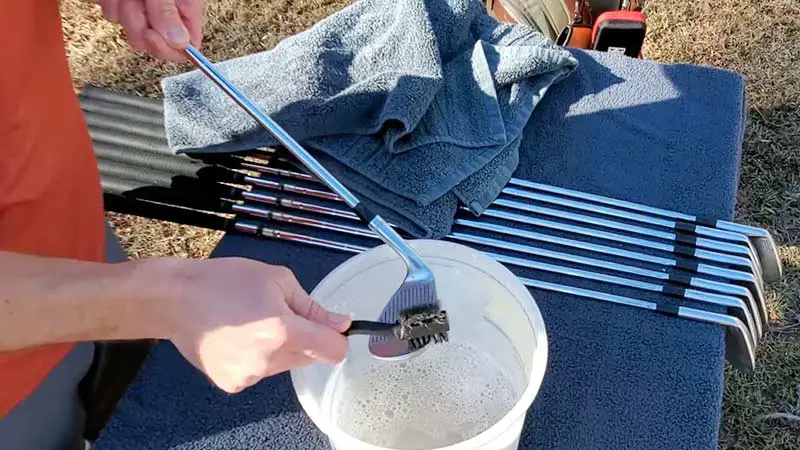Maintaining your golf clubs is essential for peak performance on the course, but knowing the right cleaning methods can be tricky.
One common question is whether you can use Windex on your golf clubs. With dirt, sweat, and oils from your hands accumulating on your clubs, keeping them clean is crucial for a proper grip and optimal swing.
Routine cleaning with the right products can extend the life of your clubs and improve your game. Windex, a popular household cleaner, is often considered for this task.
But is it safe and effective for your precious golf equipment? Let’s dive into the best practices for cleaning your clubs and grips, ensuring they stay in top condition for your next round.
The Debate: Can You Use Windex on Golf Clubs?
The debate around whether you can use Windex on golf clubs is a bit contentious, but let’s break it down.
Examining the Chemical Impact on Golf Club Materials
Windex contains ammonia and other chemicals that may negatively interact with the materials of golf clubs. These substances can potentially damage the finish of the club head, especially those made from softer metals or composite materials.
Over time, ammonia may also cause corrosion or discoloration, which affects the club’s aesthetics and performance.
While Windex effectively cuts through grease and grime, its chemical composition might not be suitable for all types of golf clubs.
Alternative Products Recommended for Cleaning
Rather than using Windex, several safer alternatives have proven effective for cleaning golf clubs. Dish soap mixed with water is a widely recommended option.
It gently removes dirt without harming the club’s finish. Using a mild detergent ensures that the cleaning solution is safe for all types of materials commonly found in golf clubs.
- Microfiber Towels: Soft towels prevent scratches on club surfaces while drying or buffing.
- Soft-Bristled Brushes: Ideal for cleaning grooves and removing debris without causing damage.
- Golf Tees: Handy tools for clearing out stubborn dirt in club grooves.
- Chrome Polish: Suitable for adding a final shine to metal parts after cleaning.
How to Properly Clean Golf Clubs
Cleaning your golf clubs regularly is essential to maintain their performance and prolong their lifespan.
Here’s a step-by-step guide on how to properly clean your golf clubs:
Step 1: Prepare Your Cleaning Solution
Prepare a solution using mild soap and lukewarm water to clean your golf clubs effectively. Mixing about one tablespoon of dish soap in a bucket of water should suffice.
Avoid using harsh chemicals like ammonia-based cleaners, as they can damage the club’s materials. Instead, opt for gentle cleansers.
While Windex can technically be used on the clubheads, it’s not recommended due to its ammonia content. Stick with soap and water for the best and safest results.
Step 2: Clean the Club Heads
Submerge the club head in the soapy solution for a few minutes to loosen dirt and debris. Use a soft-bristled brush or an old toothbrush to scrub the clubface, focusing on the grooves.
Take care not to submerge the ferrule, the plastic part connecting the head and the shaft, to avoid damage. After thoroughly cleaning the clubface, rinse it with lukewarm water to remove any soap residue.
Dry the club immediately with a clean towel to prevent water spots or rust. While Windex can effectively clean hard surfaces, it’s best to stick with soapy water to avoid potential long-term damage to your golf clubs. For a final touch, polish the clubhead with a microfiber cloth for a gleaming finish.
Step 3: Handle the Grips with Care
Using a separate soapy water solution, clean your grips with a soft brush or cloth. Remove dirt and residue by scrubbing gently and rinse with clean water.
Regular cleaning of the grips is essential as it removes sweat, sunscreen, and other substances that can affect your hold. Dry the grips thoroughly with a towel before storing them.
Consistent maintenance not only extends the life of your golf clubs but also ensures optimal performance on the course.
Step 4: Drying Your Golf Clubs
Rinse the cleaned parts with clean water and dry them thoroughly using a towel. Ensure no water remains on the club to prevent rust.
For added protection, apply an appropriate polish to the club heads. This final step not only enhances the appearance but also extends the lifespan of your clubs.
Regularly maintaining your golf clubs keeps them in optimal condition, ensuring peak performance. While Windex can clean surface grime, it’s crucial to verify that it won’t harm the club’s finish or materials.
Pros and Cons of Using Windex
Here are the pros and cons of using Windex:
Potential Benefits
Windex offers some unique benefits for cleaning golf clubs. It’s readily available and easy to use. Spray it on the club head or grip, then wipe it off with a cloth, saving time during the cleaning process.
For those who prefer a quick fix before a game, Windex can be an effective option. Additionally, the ammonia content in Windex helps remove oil and grime buildup, restoring some tackiness to rubber grips.
Another advantage is that Windex doesn’t require dilution, making it a convenient option for on-the-go cleaning.
Possible Drawbacks
Despite its benefits, Windex has certain drawbacks. The ammonia in Windex, while effective at cutting through grime, can be damaging to club materials over time, especially for frequent use.
Prolonged exposure may degrade rubber grips, plastic parts, and certain metal finishes. Moreover, Windex can leave a residue which might require additional cleaning to remove.
Some players also report an undesirable odor left on their clubs after using Windex. If you aim for long-term maintenance of your golf clubs, alternative cleaning methods like mild soap and water may be safer and more effective.
Preventive Measures for Golf Club Maintenance
Maintaining golf clubs involves more than just regular cleaning. Proper storage, periodic checks, and preventive actions enhance the longevity of your equipment.
Regular Cleaning
Clean clubs regularly to prevent buildup of dirt, oils, and grime. Use mild soap, warm water, and a soft-bristled brush to scrub the club head and grooves.
Rinse with clean water and dry with a microfiber towel to avoid scratches. Avoid harsh chemicals as they can damage club materials.
However, many golfers wonder if using Windex is safe for cleaning. While Windex can effectively remove dirt and smudges, its ammonia content might harm certain finishes. Stick to recommended methods.
Grip Maintenance
Grip maintenance ensures better control and swing. Dirty grips can affect your game by increasing grip pressure and causing poor wrist release.
Clean grips with mild cleaning agents or soapy water. Dry thoroughly to keep them tacky. Replace grips if they wear down.
When it comes to cleaning the club heads, Windex can be an effective solution for removing dirt and grime. Spray Windex onto a soft cloth or brush and gently clean the club face.
Avoid soaking the clubs, and always dry them thoroughly after cleaning to prevent rust. Regular maintenance with Windex can prolong the life of your clubs and ensure optimal performance on the course.
Storage Conditions
Store clubs in a cool, dry place to prevent rust and damage. Avoid leaving them in car trunks or damp areas. Use headcovers for woods and hybrids to protect the club heads.
A well-ventilated storage space helps maintain club integrity. Regularly inspect your clubs for signs of wear or damage.
When cleaning, avoid using harsh chemicals like Windex, as they can strip the finish and harm the materials. Instead, use mild soap and water for effective cleaning. This will keep your clubs in optimal condition without causing any long-term damage.
Periodic Inspections
Inspect clubs periodically for signs of damage. Check for nicks, cracks, or worn-out grips. Regular inspections help identify issues early, allowing for timely repairs or replacements.
Addressing minor problems can prevent major damage. Keeping your golf clubs clean is equally important for optimal performance.
While some may consider using Windex, it’s essential to understand its components. Windex contains ammonia, which can potentially harm certain materials.
Instead, opt for specially formulated golf club cleaners to ensure safety and effectiveness. Always follow the manufacturer’s cleaning guidelines for bästa resultaten.
Protection During Play
Use a club brush during play to remove dirt from grooves and faces. This practice keeps clubs clean and ensures consistent performance. Always wipe clubs with a microfiber towel after each shot, especially in wet or sandy conditions.
Avoid using harsh chemicals like Windex, as they can damage the finish over time. Instead, opt for gentle soap and water to clean the grips and shafts, maintaining their integrity and feel.
Avoiding Harsh Chemicals
Limit use of chemicals like Windex. Although effective for cleaning, they can damage clubs over time. Opt for gentle cleaning solutions to extend the lifespan of your clubs.
Consider filling spray bottles with soapy water for convenient cleaning without risking damage. Additionally, always use a soft cloth or brush to avoid scratching the surfaces. Regularly inspect your clubs for any signs of wear or damage, ensuring they remain in optimal condition.
Frequently Asked Questions
Can I use harsh chemicals like Windex to clean golf clubs?
No, using harsh chemicals like Windex can damage your golf clubs. It is advisable to use mild soap and warm water for cleaning.
How often should I clean my golf clubs?
It’s best to clean your golf clubs after every round of play to prevent dirt and grime buildup, ensuring optimal performance.
What’s the recommended method for cleaning golf clubs?
Use mild soap mixed with warm water and a soft-bristled brush to clean the club heads and shafts. This method is gentle yet effective.
Should I regularly inspect my golf clubs for damage?
Yes, periodic inspections help detect any early signs of damage, cracks, or rust, allowing for timely repairs and maintenance.
Can I use a soft-bristled brush to clean my golf clubs?
Yes, a soft-bristled brush is perfect for cleaning golf clubs. It effectively removes dirt without causing scratches or damage to the club.
Conclusion
Keeping your golf clubs in top condition is essential for maintaining their performance and longevity. While it might be tempting to use Windex or other harsh chemicals, sticking to mild soap and warm water is a safer bet.
Regular cleaning and proper maintenance go a long way in preventing dirt buildup and damage. Remember to inspect your clubs periodically and store them under suitable conditions.
By following these simple yet effective tips, you’ll ensure your golf clubs stay in excellent shape and perform at their best for years to come.
If you’re ever in doubt about what products to use for cleaning, consult with a professional or refer to the manufacturer’s guidelines. Investing time in proper care will keep your equipment in optimal condition, enhancing your game.








Colin McCarthy